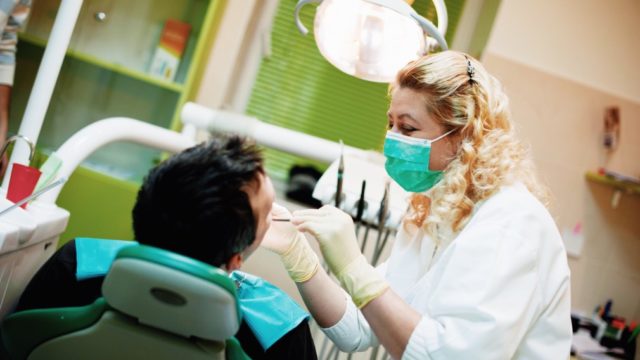
Article at a Glance
- Deep cleaning treatment is a special cleaning of the teeth also called periodontal cleaning or scaling and root planing.
- Deep cleaning treatment could be recommended if you have not been seen by a dentist in a while and have significant plaque build-up or moderate gum disease.
- Your dentist will evaluate your mouth and make recommendations based on your individual needs.
- After a deep cleaning treatment, it’s important to follow all recommendations including a regular oral care routine to ensure proper healing.
- Periodontal disease is preventable and even curable in its earliest stages.
What is a Deep Cleaning Treatment?
A deep cleaning treatment is different from the regular cleanings done on routine follow-ups to the dentist. Also known as periodontal cleaning or scaling and root planing, this special cleaning is reserved for people who have not seen a dentist in a long time and have significant plaque build-up or those with moderate gum disease.
Gum disease, or periodontal disease, is caused by the build-up of plaque. When plaque builds up on the teeth it irritates the gums and they become inflamed. If left untreated, the inflamed gums will pull away from teeth to form pockets which trap more plaque and bacteria. As the disease progresses, bone and tissues around the teeth sustain damage which can lead to tooth loss.
When is a Deep Cleaning of Teeth Necessary?
Usually, scaling and root planing is suggested when the pockets that developed have reached five millimeters or more, but that is only part of the determination. People who have substantial plaque build-up may benefit from a thorough cleaning to get them back on track with their oral health. Your dentist will perform a comprehensive exam and make the best recommendation for you.
What Happens During a Deep Cleaning Treatment?
Depending on the amount of work to be done, a deep cleaning treatment can occur in one visit or over multiple visits. The process involves removing plaque and tartar all the way around the tooth with metal scaling tools, ultrasonic instruments, or a laser device. Your dental hygienist will then use an ultrasonic device and curette to remove any remaining plaque. Finally, the entire affected area will be irrigated with an antibiotic. This process should allow the gums to heal and reattach to the teeth.
What to Expect After a Deep Cleaning Treatment
Dentists may prescribe medication for the pain, to control infection, and to help healing. It is important to follow the prescribed treatment, including a good oral care routine, to ensure the teeth and gums an opportunity to heal properly. Regular follow-up visits will be necessary to gauge the progress. If you are a smoker, it will be advised that you quit as soon as possible since smoking contributes to gum disease.
How to Prevent Periodontal Disease
Periodontal disease is preventable. Following good oral care routines including regular check-ups and professional teeth cleanings is crucial. When you’re seen every six months, it’s easier for your dentist to catch small issues before they develop into big problems.
If it’s been a while since you’ve seen a dentist or you know it’s time for that six-month follow-up, take a few minutes to make an appointment. Contact the Jefferson Dental Care Clinic nearest you to get scheduled today!
Additional Sources:
https://www.ameritasinsight.com/wellness/dental/gum-disease-deep-cleaning
http://www.ada.org/en/~/media/ADA/Publications/Files/ADA_PatientSmart_Perio_Disease




